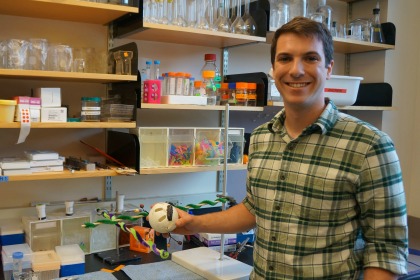In cells, cargo that contains tiny packages of critical biological material, such as insulin, are transported by teams of minuscule myosin molecular “motors” along complex actin filament “highways.” How these motors reach their destination when confronted with numerous intersections without GPS is a mystery. In a new study published in Nature Communications, University of Vermont researchers built three-dimensional (3D) actin highways with intersections as well as under- and over-passes within microfluidic chambers to emulate the complicated highways that myosin motors see in cells.

Photo: LCOM Creative Services
In cells, cargo that contains tiny packages of critical biological material, such as insulin, are transported by teams of minuscule myosin molecular “motors” along complex actin filament “highways.” How these motors reach their destination when confronted with numerous intersections without GPS is a mystery. In a new study published in
Nature Communications, University of Vermont researchers built three-dimensional (3D) actin highways with intersections as well as under- and over-passes within microfluidic chambers to emulate the complicated highways that myosin motors see in cells.
“We challenged motors to navigate their cargo along suspended filament tracks through intersections with the intention of understanding how teams of these motors work together when faced with a directional dilemma,” says Andrew Lombardo, a graduate student in molecular physiology and biophysics at the Larner College of Medicine at the University of Vermont.
He and colleagues in the lab of David Warshaw, Ph.D., chair of molecular physiology and biophysics, used tiny, 3 micrometer-sized beads in these special chambers, as structural supports to spin a web of suspended actin filament highways between the beads.
“Similar to a tightrope artist carefully walking between two buildings, myosin motors bind to the suspended actin highways while carrying their cargo and ‘walking’ along these tightropes,” said Lombardo.
He and his colleagues observed that the motors were surprisingly adept at moving their cargo through the complex physical and directional challenges presented by these 3D highways.
“Actin filaments and intersections are numerous in the cell – for the motors, it’s like navigating a city," says Lombardo. "However, you would never make it across town if you turned at every intersection."
In fact, myosin motors prefer to turn at intersections when such intersections are formed on flat surfaces. But when suspended 3D highways and intersections were created, teams of motors now carry their cargo in a relatively straight line through the intersections despite the option to turn or stop.
View a video demonstration here >>
“This simple model transport system provides a window into one of the most fundamental processes that occurs in every single cell within the human body," says Lombardo. "In diseases like cancer, the actin highways are messed up. Having a strong understanding of Mother Nature’s engineering design principles will help support the development of therapeutics for these devastating diseases.”
In addition to Lombardo and Warshaw, co-authors on the study include UVM Molecular Physiology and Biophysicists Shane Nelson, Yusuf Ali, Guy Kennedy, and Kathleen Trybus, as well as Sam Walcott of the Department of Mathematics, University of California, Davis. This work was funded by the National Institutes of Health, National Science Foundation, and the National Aeronautics and Space Administration.